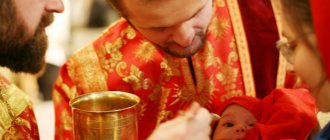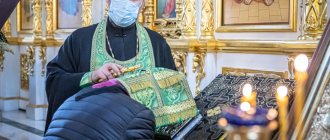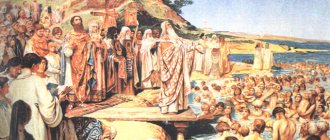The concept of royal liturgy in Orthodoxy
After the February Revolution of 1917, the Holy Synod, under pressure from the Provisional Government, abolished the royal days and changed the content of the liturgy, excluding petitions concerning the royal person.
In the Russian Empire, 10 holidays were established in honor of special events in the lives of members of the royal family.
In each case, a different prayer service was served:
- on your birthday - thanksgiving;
- coronation - according to a special rank;
- namesake - to the saint of the same name.
From March 1917, these services were cancelled. In memory of the execution of the royal family in the Yekaterinburg diocese, every year from July 14 to 19, divine services are held with a procession of the cross to the place of death of the royal persons.
At the Zadonsky Monastery, the rite of a custom liturgy called the Tsar’s was introduced into practice. This service differs from the custom-made mass and proskomedia.
The church charter includes:
- proskomedia;
- mass;
- litany;
- special request.
During the liturgy, only those names that were submitted in the note for this request are read.
Chapter II: about the Divine Liturgy, or mass
§ 82.Reading the Apostle and the Gospel
at mass he presents to us the actual sermon of our Lord, I. Christ, and His Divine Apostles, and through this constitutes one of the most important and instructive liturgical rites; therefore, it is both preceded and accompanied, and concluded with many significant “exclamations”, various instructive actions and “solemn chants”.
After “come, let us worship”, and after singing, or reading, for “come”, the daily “troparion with kontakion”, 1), the priest, standing in the altar before the throne of the Trinitarian Deity, for the all-illuminating and all-enlightening gifts sent down from Him the Holy One, awakens those approaching His worthy glorification, with the cry: For Thou art Holy, our God, and to Thee we send glory, to the Father and the Son, and the Holy One. To the spirit...
2) In response to this exclamation, after the usual:
Amen,
in the choir they sing the so-called
Trisagion158
, that is, a short “angelic doxology” in honor of the Most Holy Trinity159:
Holy God
(Divine Father),
Mighty Holy One
(who conquered death by the strength of the Divine omnipotence and hell, i.e. the Son of God)
Holy Immortal -
(immortality and eternal life giver - the Holy Spirit),
have mercy on us!
And on R. X., on Epiphany, on Lazarus Saturday, throughout the week of Easter and on Spiritual Day, instead of the “angelic doxology”, in remembrance of the fact that in the primal church, during these holidays, there were many newly baptized, and together, for the deliberate glorification of our Savior, as the main culprit of all our celebrations and spiritual celebrations, a solemn baptismal song is sung:
those
who
were baptized
into Christ
(in the sacrament of baptism) (believed and recognized in Him their only Savior)
put on Christ
(accepted Him teaching, rules, way of life - were sanctified by His sacraments, overshadowed by Divine grace, covered with His ineffable mercy, in a word, as if clothed, imagined in Him - and you, who were baptized in this way, sing, like all of us - those who were baptized before you – sing):
alleluia! –
3) During the threefold chanting of the “trisagion”, the clergy, reading it themselves three times, bow the same number of times before the throne, and when they sing for the fourth time:
glory to the Father….and now….. amen, Holy Immortal, have mercy on us,
or:
put on Christ, alleluia;
then, having kissed St.
throne, when singing the “trisagion” for the fifth time, they go behind the throne, to the so-called high place160.
4) When the clergy stand behind the throne, the final preparation of those present for attentive listening to the word of God is made: a) with the usual exclamations:
there is mem, peace to all!
and to your spirit, wisdom; b) reading and singing the daily
routine161
, and c) repeating the invitation to attentive listening
: wisdom!
indicating the epistle from which the apostolic reading will be offered: e.g.
second conciliar letter of St.
An. Peter's reading, and finally:
Vonmem,
followed by the reading itself.
5) During the reading of the Apostle162 and together before the reading of the Gospel, the deacon (and without the deacon the priest himself), as a sign of the beneficial influence of revealed teaching on the hearts of believers, censes the altar with femiam, St. icons of the iconostasis, the reader and generally all those praying; and the priest, at the same time, or, if he serves alone, after performing the censing, as the chief priest, or the eldest in his church, that is, in a certain society of believers (or in the parish), sits at the throne, to express that instructive truth that the reading scripture, or “epistle” of one or another Apostle (not excluding Apostle II), to one or another church, or, more precisely, to one or another of the leaders of the church (which, in their time, were some of the Apostles, and after the Apostles, as well as in our times, their successors), is a message from an equal in power and rights to an equal without any domination or predominance, with only fraternal or purely Christian motivation and influence. – 6) After the end of the Apostle, to the well-wishing spoken by the priest to the reader: peace be with you,
this latter responds with the usual:
and to your spirit,
and adds, turning to the singers:
a voice
like this:
alleluia,
which the singers, when the reader says special verses, and sing three times .
– 7) Before the reading of the Gospel, the preparatory exclamations are repeated again, with a significant expansion and change in them, in relation to the reading of the Gospel. So, a) if a deacon participates in the service, then he begins with the following exclamation, addressing the priest: bless
(admonish with goodwill and benevolence),
master, the evangelist
(i.e., me, as a zealous, reverent herald)
of the saint.
Apostle and Evangelist (eg)
John the Theologian,
and the priest, in response to this, exclaims:
God, through the prayers of St.
may the glorious, all-validated Apostle and Evangelist, (for example)
John the Theologian, give you a verb
(an intelligible, expressive voice - to you)
who
preaches the gospel (who proclaims the word of the underworld, which in itself, in itself is strong, powerful, and therefore who preaches the gospel with)
power
(and power over the hearts of those who listen)
by me, in fulfillment
(of the purpose)
of the Gospel of His beloved Son, our Lord I. Christ.
The deacon confirms all this with the usual:
Amen,
and behind this the final views are said before the reading of the Gospel:
wisdom, forgive...
b) If the deacon does not participate in the service, then the priest, preparing for the reading of the Gospel and preparing others for listening to the second saving reading, directly, without everything said before, he proclaims:
wisdom: forgive!
Let's hear (reading)
St.
Gospel -
peace to all!
and receives in response from those who sing:
And be your spirit.
c) Finally, when he, following this answer, announces: (for example)
from John to St.
The Gospel reading, and those singing, for such a gracious joyful announcement, will glorify God:
Glory to Thee, Lord, glory to Thee;
then, after:
let us remember,
the reading itself follows, during which the candle-bearer, as a sign of the spread of the light of the Gospel - Divine, to the believers, holds a lighted candle in front of the Gospel. After reading the Gospel, the priest says to the deacon (of course, if the deacon was an evangelist):
After reading the Gospel, the priest says to the deacon (of course, if the deacon was an evangelist):
peace be with him who preaches the gospel;
and the singers, because the Lord has deigned the believers to hear the Gospel, again sing praises to Him:
glory to Thee, Lord, glory to Thee
!
– 9) In the early church, the reading of the Gospel was usually followed by an explanation of what was read, that is, a teaching was offered
;
but in our country, as has been the case since ancient times, “teachings” are offered at the end of mass; and after the Gospel, when it is sung: glory to Thee, Lord...
and the “royal doors” are closed, which were dissolved from the very “small entrance”, the “extreme ectenia” immediately follows.
Order of conduct
The Divine Liturgy according to the royal rite is conducted in the traditional sequence, but with additions to the service during the proskomedia, litany and final prayer service of the names indicated in the service and special prayers and petitions. The sequence of conducting a custom service depends on the purpose: for the repose of the deceased or for the health of the sick.
The rite of repose service at the Zadonsk Monastery includes the mention of names from the ordered note:
- at Proskomedia;
- several times at a special litany with additional petitions;
- in the priest's prayer after the exclamation.
The funeral kontakion is also sung at the Entrance “With the saints, rest your souls, O Christ...”, and funeral apostolic and gospel readings are added.
The rite of worship for health includes additional prayers:
- at the proskomedia - a special prayer from the priestly prayer book;
- at the Great Litany - six petitions from the prayer service for the sick;
- troparion, prokeimenon, readings from the Holy Scriptures about the sick;
- on a special day after the evangelical reading - three petitions for the sick from the Service Book;
- after the exclamation, the priest reads an excerpt from the prayer service for the sick “Lord Almighty...”.
Liturgies according to the royal rite for health and repose in the church are held once a week, with the blessing of the abbot of the monastery. Insertions into the text of the service should not contradict the Typikon, therefore there are time restrictions on the execution of the order.
DISTINCTIVE FEATURES OF THE DIVINE ROYAL LITURGY
Now many Orthodox Christians ask: “How exactly does the Divine Liturgy of Tsarist times differ from the current modern liturgy?” This question is not asked by chance, as people are tired of some abstract answers. The people need the truth and concrete explanations from the priest. That’s why I decided to convey in an accessible form, consistently, the main distinctive features of the Liturgy at which our All-Russian Autocrats stood and prayed.
1) Let’s take the service book from the time of our Holy Tsar Nicholas Alexandrovich for 1901 and open it at the place where the Divine Liturgy of St. John Chrysostom begins. On the proskomedia we will see a picture highlighted in red. It shows the arrangement of particles on the paten. When the priest takes out the particles during the liturgy, he places them in sequential order. First, he places the Holy Lamb in the center of the paten, then on one side a particle from the Mother of God prosphora. On the other side, there are nine particles from the Nine Prosphora, under which a SPECIAL PARTICLE is laid out for the EMPEROR. In the picture of removing particles, this is how it is defined. Just below are the particles for the SYNOD, that is, for the health of the bishops and clergy, and for the PATRIARCHES, that is, for the repose of the Kings and Queens, the most holy patriarchs and the creators of monasteries and churches. Then, even lower, two belts of particles FOR THE LIVING and FOR THE DEAD are placed on the sacred vessel.
2) The prayers before removing particles from the prosphora are very different from today’s modern prayers, although, of course, common features remain. While taking out the particle for the SYNOD, the priest prayed: “Remember, O Lord, who loves mankind, every bishopric of the Orthodox, the Holy Governing Synod, and the most holy patriarchs, (and our metropolitan, named, whose diocese is, or our bishop, named), the honest presbytery, the deaconry in Christ, and the entire priestly rank: the abbot, the name, the brethren, and our fellow ministers, priests, deacons, and all our brethren, whom Thou hast called into Thy communion, by Thy benevolence, O All-Blessed Master.”
3) When the particle for the Emperor was taken out, the following prayer sounded: “Lord, remember our Most Pious, Autocratic, Great Sovereign, Emperor Nicholas Alexandrovich of all Russia, His Spouse, the Most Pious Empress, Empress Alexandra Feodorovna, His Mother, the Most Pious Empress, Empress Maria Feodorovna , Blessed Sovereign, Heir and Grand Duke Mikhail Alexandrovich, and the entire Reigning House."
At this point in time, instead of the name and patronymic of our Sovereign, one should insert HIS NAME, LORD, YOU WEIGHT. When the Lord reveals the King to us, the need for this insertion in itself will disappear, since we will know the NAME and PATERNIC OF our FATHER.
4) The Holy Orthodox Church at the Proskomedia always prayed for the repose of the Autocratic Kings and Queens. According to the modern rite, such prayer is absent, which cannot be explained even simply from a moral point of view. The priest took out a particle from the fifth Funeral Prosphora and prayed: “For the memory and forgiveness of the sins of the most holy patriarchs, Orthodox and pious Kings, and pious Queens, the blessed creators of this holy monastery.”
5) At the Peaceful Litany the following petitions were heard: “For the Most Holy Governing Synod, (and for our Metropolitan named after his region), the most honorable presbytery, the diaconate in Christ, for all the clergy and people, let us pray to the Lord.”
“For our Most Pious, Most Autocratic, Great Sovereign, Nicholas Alexandrovich of all Russia: and for His Spouse, the Most Pious Empress, Empress Alexandra Feodorovna, and for His Mother, the Most Pious Empress Maria Feodorovna, let us pray to the Lord.”
“For the Blessed Sovereign, Heir and Grand Duke Mikhail Alexandrovich, and for the entire Reigning House: for the whole chamber and their army, let us pray to the Lord.”
“Let us pray to the Lord to help and subdue every enemy and adversary under their nose.”
6) After reading the Holy Gospel, the priest or deacon always pronounces the Extended Litany “Rtsem Vsi”, it is also called Zazdravnaya. The petitions in it have a special Theological meaning, which completely disappears in the petitions of the modern missal. This is what the prayer to God sounded like before the 1917 revolution:
“We also pray for our Most Pious, Most Autocratic, Great Sovereign, Emperor Nicholas Alexandrovich, of all Russia, for His power, victory, abiding, peace, health, His salvation, and for the Lord our God, most of all, to hasten and help Him in all, and to subjugate under His nose all enemy and adversary."
From here it is clear and distinct that the Church has always prayed for POWER and VICTORY. Orthodox Christians all over the world asked the Lord to help our Sovereign and subdue every enemy and adversary under His feet. Let us now ask ourselves a simple question: “Is there even a prayer for our victory now?!” Alas, we don’t even pray for Victory over evil. What have we come to...
Now they are praying not for the Power, but simply for “our God-protected country, its authorities and its army.” And before, the Church prayed for the Tsar as a God-established Authority. And not just about warfare, but about Christ-loving warfare.
7) The Great Entrance was truly Royal. The clergy brought the paten and chalice to the pulpit, turned their faces to the people and loudly proclaimed: “Our most pious, most Autocratic, Great Sovereign, EMPEROR Nikolai Alexandrovich of all Russia, may the Lord God remember in His Kingdom, always, now and ever, and to the ages of ages. His wife, the Most Pious Empress, Empress Alexandra Feodorovna, may the Lord God remember him in His Kingdom, always, now and ever, and forever and ever. His Mother, the Most Pious Empress, Empress Maria Feodorovna, may the Lord God remember him in His Kingdom, always, now and ever, and forever and ever. The Blessed Sovereign, Heir and Grand Duke Mikhail Alexandrovich, and the entire Reigning House, may the Lord God remember in His Kingdom, always, now and ever, and forever and ever. May the Lord God remember the Most Holy Governing Synod in His Kingdom, always, now and ever, and forever and ever. May the Lord God remember all of you, Orthodox Christians, in His Kingdom, always, now and ever, and forever and ever.”
Please note that there is no trace of any “great master” here. The Royal Family, the Reigning House and the Holy Governing Synod are listed as the Council of Bishops. Here is the fullness of the Royal Power, as well as the fullness of the episcopal power. What else do we Orthodox need? Is it really possible to somehow change these God-established Authorities? We must pray for the King, as this is our duty to God. And we must pray for the Synod, if only because no one has canceled it. He remained as he was. And in it lies the fullness of episcopal power.
 After the exclamation “A lot about the Most Holy, Most Pure, Most Blessed, Glorious Lady of our Theotokos and Ever-Virgin Mary.” the secret Eucharistic prayer follows. In it, the Holy Mother of our Church always prayed especially for the Sovereign Emperor, filling Her prayers with unique Theological meanings. This is how an excerpt from this prayer sounded at the liturgy of St. John Chrysostom, now thrown out of the modern missal:
After the exclamation “A lot about the Most Holy, Most Pure, Most Blessed, Glorious Lady of our Theotokos and Ever-Virgin Mary.” the secret Eucharistic prayer follows. In it, the Holy Mother of our Church always prayed especially for the Sovereign Emperor, filling Her prayers with unique Theological meanings. This is how an excerpt from this prayer sounded at the liturgy of St. John Chrysostom, now thrown out of the modern missal:
“We also offer this verbal service to You, about the Universe, about the Holy Catholic and Apostolic Church, about those who live in purity and honor: about our Most Pious, Most Autocratic Great Sovereign, Emperor Nicholas Alexandrovich of all Russia: about His Spouse, the Most Pious Empress, Empress Alexandra Feodorovna: about His Mother, the Most Pious Empress, Empress Maria Feodorovna, about the Blessed Sovereign, Heir and Grand Duke Mikhail Alexandrovich, and about the entire Royal House, about the entire chamber, and their army. May God grant Them a peaceful Kingdom, and in their silence we too may live a quiet and silent life, in all piety and purity.” To feel the strong semantic resonance between the Royal Prayer and modern democratic prayer, it is enough to read the current service book in the same place: “about our God-protected country, its authorities and its army. Grant them, Lord, a peaceful reign, and in their silence we too will live a quiet and silent life, in all piety and purity.”
In this example, it is important to understand that our ancestors used to ask for a PEACEFUL KINGDOM, and today we are asking for some kind of peaceful reign. It is clear that the petitions are different, hence the result is different. As we pray, so we receive.
9) You can also see and realize what an important piece of this same prayer is now missing from the Liturgy of St. Basil the Great. Here the Theological meaning generally makes the soul tremble with its significance, since it actually proves the need to pray for the Royal Power. This is the prayer that at one time deeply sank into my soul and prompted me to begin to pray according to the Royal Missal:
“Lord, remember our Blessed and Christ-loving Sovereign Nikolai Alexandrovich, Emperor and Autocrat of All-Russia, WHO HAS JUSTIFIED TO REIGN ON EARTH, WITH THE WEAPON OF TRUTH, WITH THE WEAPON OF BLESS CROSS HIM, AUTUMN OVER HIS HEAD ON THE DAY OF BATTLE, STRENGTHEN HIS MUSCLE, Elevate HIS HAND, KEEP HIS KINGDOM , SUBMIT TO HIM ALL BARBARIAN TONGUES WHO WANT TO BATTLE, GIVE HIM DEEP AND ESSENTIAL PEACE, SAY GOOD THINGS IN HIS HEART ABOUT YOUR CHURCH, AND ALL YOUR PEOPLE, SO IN THE SILENCE OF HIS QUIET AND SILENT LIFE WE LIVE, TO ALL WHOM OF PIETY AND PURITY."
I realized when I read these words that the Lord Himself wants the priesthood to pray for the King, since He has already justified Him to “reign on earth.” It is simply the Will of God that He should exist, which means He exists, He is always with the Lord. And only in His silence will we live in all piety and purity. No other power will give us what the Autocratic Sovereign will give, since only Royal Power is pleasing to God and therefore established by Him. Just as a father is the head of a family, so the Tsar in Rus' is the Head of the Church and the Father of the people. Without Him there would be no Russia, like a body without a head.
10) At the Prayer beyond the Ambon the Emperor was always remembered, which is not done now. Although the Greeks still remember the Kings at the prayer behind the pulpit. They don’t seem to have a monarchy either, but they pray the same way as was customary in the Byzantine Empire.
11) After the dismissal, the choir always lived for many years of the Emperor, and now in the place of the Tsar, the “great lord” Patriarch of All Rus' lives for many years. This is how the Tsar's Many Years sounded: “Our Most Pious, Autocratic, Great Sovereign EMPEROR Nikolai Alexandrovich of all Russia, His Spouse, the Most Pious Empress, Empress Alexandra Feodorovna, His Mother, the Most Pious Empress, Empress Maria Feodorovna, and His Heir, the Most Pious Sovereign Tsarevich and Great whom Prince Mikhail Alexandrovich, the Holy Governing Synod, and all Orthodox Christians, God save Them for many years.”
Now in the modern service book, wherever possible, the Royal Seat is occupied by the patriarch. And this is very reminiscent of the situation from the Old Testament, when Aaron was chosen as the high priest instead of Moses. Moses came with the tablets of the Covenant and saw the worship not of God, but of the golden calf. We see the same thing in the Vatican, when the bishop of the city of Rome is called the vicar of Christ on earth, that is, the Anointed One. The Pope actually sits illegally on the Royal Throne. He is called the head of the Roman Church and at the same time the head of the entire Vatican State. And for Catholic papists he is associated as the father-pope of the people - the Tsar. For us Orthodox, this is a papist heresy. But, for some reason, we realize this only through our native Royal Liturgical Rite. When we pray according to the modern rite, we are not far from the Pope of Rome, creating with such prayer another pope, the Patriarch of Moscow and All Rus'. May this not happen to us! We are Russians, which means God is with us! The Lord admonishes us all through the Divine Liturgy of Tsarist times. Amen.
Sincerely, Father Roman Zelensky.
Film about the Divine Liturgy according to the Royal Rite
How to order a rank
The royal liturgy is ordered by submitting a registered note in a candle box.
There are certain rules for its submission that must be followed:
- You can order a commemoration only for those baptized into Orthodoxy and those who believed/believe in God. (Those who were baptized when they were young but who are actively opposed to the Orthodox Church should not be remembered).
- Names given at baptism are indicated in the genitive case.
- It is impossible to write down “About Health” for unborn children, since they are unbaptized.
- The note must have a title (Note for the Royal Liturgy of Repose/Health).
The registered note must be filled out in neat, legible handwriting. Simultaneously with ordering the request, you are supposed to make a donation for the needs of the temple.









